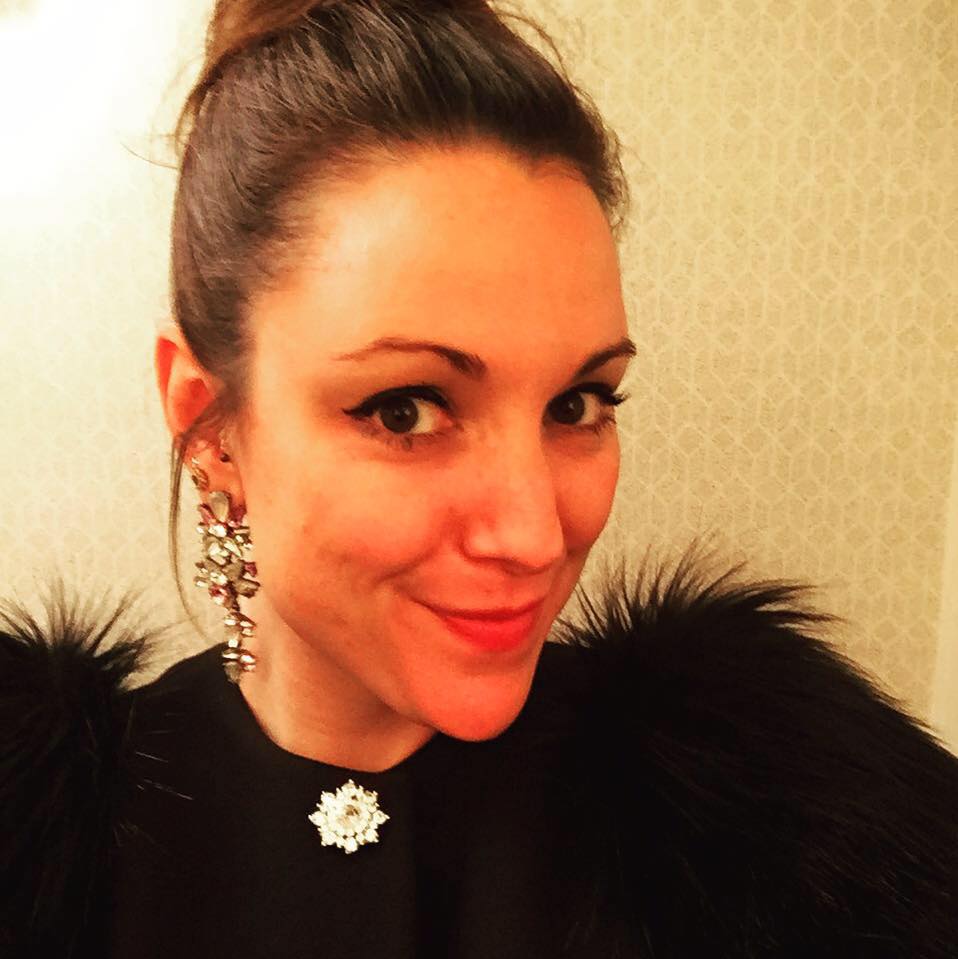Telling millions of readers a month about the hottest and upcoming trends was Susan Swimmer job. She interviewed some of the biggest celebrities, designers and influencers in the world while working at iconic magazines like Marie Claire, Cosmopolitan, Glamour, Seventeen, SELF, Ladies’ Home Journal, Conde Nast Traveler and was sought out to appear on major TV shows like the“Today Show,” “The Oprah Winfrey Show,” “Good Morning America,” and “Entertainment Tonight” to discuss the latest in fashion and celebrity news.
While she spent her career making others famous, the style and pop culture expert always had the the desire to go off on her own and create something big and meaningful. After her mother passed away in 2003, Swimmer inherited her things and found a unique trio of necklaces—bold, sculptural, saturated in color—that she started wearing. She searched the globe to find them again, but they didn’t exist. It was in that moment she knew what her mission was — to create something she loves from a memory of someone she loves. Evie Marques, named after her mother Evelyn, was born.
“The goal is to build an accessories brand with an aesthetic that’s all about saturated color and bold design,” Swimmer tells Thrive. “I want women to learn how to be confident about the way they look—be brave!—and I also want to bring a little happy into women’s lives.”
She talk to Thrive about what it’s really like to chase a dream and accomplish your goals.
Thrive Global: Tell us about your company. What is your mission?
SS: When my mother died in 2003, I was her only daughter, so her things became my things. I found a couple of necklaces tucked in the back of one of her drawers, and I immediately liked them—they were so different than anything I had seen before. They were made of chunky, unusually shaped beads, in a material I didn’t recognize, and they were bold and saturated in color. I started wearing them allllll the time, and they made me feel great—stylish and confident. Moreover, EVERYONE asked me about them. It literally became a drum beat, no matter where I was in the world, and I always said to my husband that I should make something inspired by them (and he agreed!). But I was working hard in jobs I loved, and my children were really young, and the years went by. Eventually things shifted—work became less fulfilling, my kids were growing up, I was spent from corporate life—and I knew it was time. I had worked 25+ years in magazines and TV (editor, correspondent), mostly focused on fashion, and I knew I wanted to do something in that wheel house. What did I love? Accessories, especially jewelry.
And just like that, it all clicked. I launched about a year and a half ago—with the “Jane” necklace that’s inspired by my mother’s piece, and that I do in about 35 different colors. I’m about to release two new iterations of the necklace, along with an earring and a ring. Soon I’ll release a bag.

TG: What was the hardest part about starting a new company? What advice would you give others wanting to try?
SS: The hardest part was getting over the fear. The fear of starting something new, of not knowing what I was doing, of failure. But my friends and family were so supportive, and that, along with my drive, pushed me along. My advice? Make peace with the fact that you won’t know what you’re doing but that you will be able to find people and resources to fill in those gaps. Early on, when I was still in my former full-time job, I knew I was intimidated by the business/financial aspect of starting a business (even just the idea of writing a business plan was scary). So right away I enrolled in two business classes (at night) and that helped a lot. Speaking practically, I advise anyone interested in starting a business to save seed money in advance, which can take years, and to start planning a business when you’re still working in another job (so you have that income while you plan).
TG: What small steps do you use to accomplish your ultimate goal? How do you stay on track?
SS: I don’t get too far ahead of myself—I plan months in advance, not years in advance. I make a 6-month plan (setting goals in terms of creative, sales, exposure, priorities), and then when that goes by I make another 6-month plan. Eventually I’d like to graduate to thinking in years instead of months, LOL.
TG: What is one small habit that has improved your life significantly?
SS: I set aside specific times of the day for calls and emails. For me, I do it first thing in the morning and late in the afternoon. Because in the beginning I was crazed all day long, fielding calls and emails while trying to think creatively and plan production and that didn’t work at all. I was scattered. I’ve always been pretty regimented about my day (when I wake up, exercise, work, eat, etc.) but when I launched my business and suddenly worked from home, all that regimentation kind of fell away. I quickly realized I had to get back on track.
TG: How do you approach workplace stress?
SS: I can’t say I have workplace stress because it’s still just me doing everything (I do hire consultants for specific projects, but they’re almost always in their own offices, often in other states). The stress battle for me comes at night when I worry, and I do experience periods of sleeplessness that I still deal with to this day. I’ve learned to keep a pad of paper by my bed so I can write things down in the middle of the night. It helps a little.
TG: What are 3 things that help you thrive in the office?
SS: I have a designated work space, I adopted two rescue cats that keep me company during the day, and I have regular weekly check-in calls with a couple of people I rely on for guidance.
TG: Can you share one story of when you went from surviving to thriving?
SS: I’m not sure I’m thriving quite yet, but I have made back almost all of the money I put into the business and that feels really good. My biggest hurdle to this day was getting my manufacturing in place, and that was really hard. It took many months and I hit many walls. At my lowest moment I was literally on my hands and knees, just overwhelmed with frustration (it’s a long story, I’ll save it for the book!). I got past it by working through the problem day and night over the course of an intense 4-day period, but it turned out to be a really valuable lesson for me that I go back to again and again, remembering that I was able to get through it. My mantra? Breathe, think, problem solve.
TG: What type of work environment do you thrive in? Why?
SS: The funny thing is I think I thrive in an environment where I can interact and bounce ideas off of others, because at my core I’m an extravert who likes the energy and ideas that come from other people. But I don’t have that yet (in my “office”) so I have to go out to get that by making a real effort to meet with friends and colleagues who feed me in that way.
TG: What are your travel tips for staying on track during long trips?
SS: This has been a bit of a challenge for me because although I can stay connected to my business no matter where I am in the world, I can’t fulfill orders when I’m in, say, Croatia. If I get an order on my website and I can’t physically fulfill it, I send an email and people are really understanding (I also waive the shipping fee in those instances). Having a teenage daughter still living at home also helps fill in those gaps in a pinch.
TG: With so many distractions and interruptions coming at us throughout the day. What are your tips to stay focused?
SS: See above, where I have learned to block out specific times during the day for calls and emails. I also really limit the amount of time I spend on social media, and I barely watch TV. I just find those things to be huge time wasters and not very inspiring.
TG: What is your relationship with feedback? Do you ever struggle to give or receive feedback?
SS: Great question! Getting feedback is really important but, not going to lie, is sometimes really hard to hear. It comes in all forms—people say things to me directly, they send me emails, comment on social media, communicate through my website. In the beginning I took every single negative comment or “helpful suggestion” that I heard to heart, and I would immediately think about course correcting. But then I calmed down and learned to listen but not necessarily act. That said, when I hear the same thing over and over again, I address it.
TG: What are 3 things that make a successful meeting?
SS: I write an agenda in advance and circulate it to all involved, at the end of the meeting I sum up what has been decided (and who will do what), and then I follow up with an email that spells out next steps and when those steps are expected to happen. I learned this in my old work life and it’s still incredibly helpful.
TG: What do you do when a project or personal goal isn’t on track? What small steps can you take to get it back in motion?
SS: This is when I lean on my inner circle. I have a handful of close friends who have been lifelines for me since I started the business and I’m so grateful for them. The other thing I’ve learned is that sometimes things stall because circumstances are simply out of my control. For instance, one of my factories had to close for a few months, totally unexpectedly, and it set everything behind. Instead of getting frustrated, I turned my attention (and energy) to other projects while I waited it out. When you’re building a business on your own, the one thing you can always be assured of is that there’s always another task that needs to get done.


